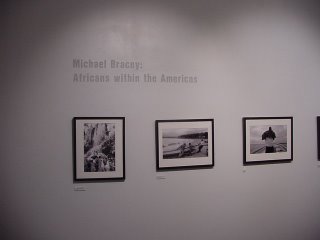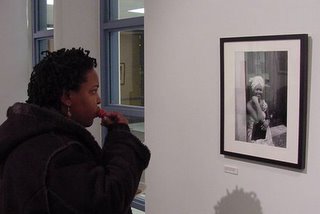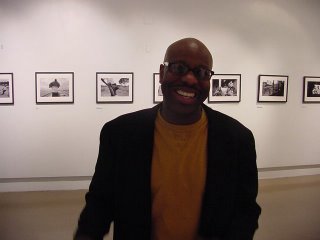
Bracey has traveled throughout the Americas and Africa photographing people of African descent, and one of the aims of this show was to show the commonalities across national, ethnic and linguistic boundaries, which his fine, evocative photographs achieve.
He took the photos in this exhibit in the US, Belize, Brazil, Cuba, Dominican Republic, Haiti, Panama, Jamaica, and Ghana, and in some cases, it was hard to tell, at least at first glance, where the people captured in the images were from. I played a little game where I would not look at the captions but just guess, and the only ones I got correct were the photos from Salvador da Bahia (which has very distinctive architecture), and one shot of Dominican men laughing (though it could easily have been a shot of non-Dominicans photographed in, say, Maryland or Virginia).
The photos in the exhibit are all black-and-white; their formal strength lies in their assured composition, framing, and use and contrast of light and shadow. What appeals to me about many of them is their in medias res quality, which is to say, how they mostly do not feel staged and plunge us right into scenes from lives as they're playing out. There are a few portraits, which interested me less (though the one of the young Baiana featured below is lovely) than the others freezing a moment in the subject's everyday experiences that gain poignancy because of Bracey's artistry. Perhaps my favorites were a shot of a young Jamaican guy, from the back, his dark back contrasting against the sky, his short twists peaking from beneath his leather cap; a triptych of an old man walking up a street in Panama; and another featuring a father and child in rural Bahia, the child stretched out, its arms up, waiting to be embraced or even lifted, between his father's legs, as the rural homestead and parched landscape hovered in the distance.
One thing I wondered was what would sort of photos might result from visiting spots in these countries that are not particularly known for having a strong "African" imprint, but which do have distinct populations of African-descended people? So for example, in Brazil, in addition to Salvador, what about Rio de Janeiro (which struck me on each visit as a "Black" city) or São Paulo, or even somewhere in the south of that country, like Porto Alegre, which has a small Black population (and a slave history, etc.)? In the US, what about Denver, or Los Angeles, or Oklahoma City? What sorts of commonalities, both to the better known Black metropoles (Washington, New York, Port-au-Prince, Santiago de Cuba, etc.) and in transnational, transdiasporic terms, might arise? Another thing I thought would be to see what Black Europe or the Black Middle East (problematic as these terms are) looked like, as well as what I think of as the imaginary African-America in other parts of the non-African-Diasporic world (say, in Fiji or New Zealand). Oh well--Bracey is only one person, and this is an ongoing project. He did mention that his next project would involve photographing Blacks in Mexico, which I think is incredibly timely, so I'm going to look out for it.

Here's Raquel checking out one of my favorites of the photos. It depicts a young Bahian woman taking a break from her job as a restaurant tout.

Some of the people at the reception

The artist Michael Bracey.
If you're in the Chicago area and are interested in catching the exhibit, it's at
5500 North St. Louis Avenue
Chicago, IL 60625
773-442-4944
The show runs until February 24.
To see a lot more of Michael Bracey's photos and purchase his book, you can check out his website.









No comments:
Post a Comment